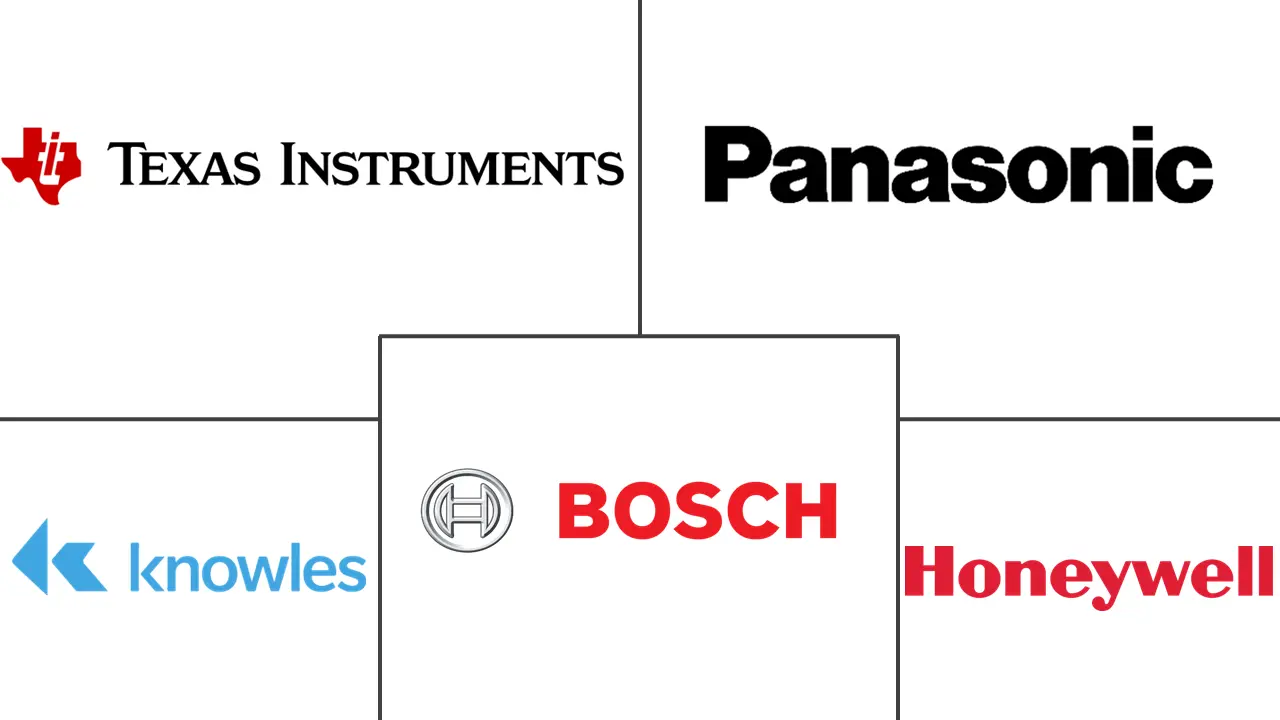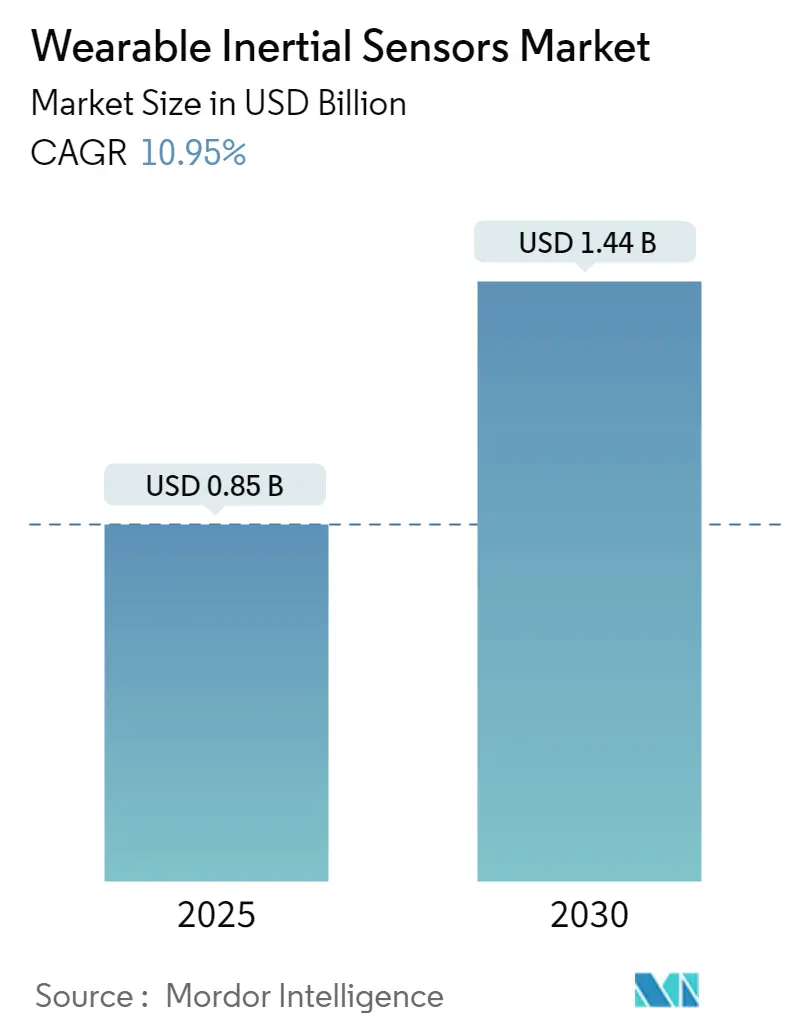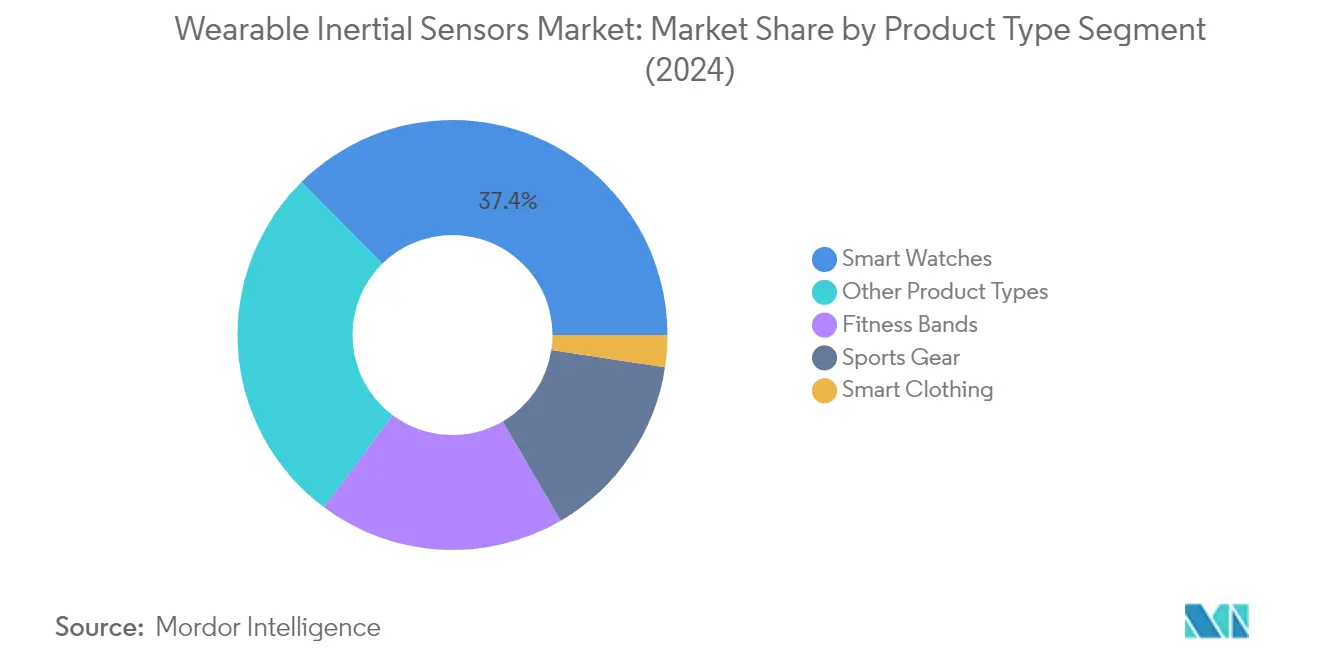Wearable Inertial Sensors Market Analysis
The Wearable Inertial Sensors Market size is estimated at USD 0.85 billion in 2025, and is expected to reach USD 1.44 billion by 2030, at a CAGR of 10.95% during the forecast period (2025-2030).
The wearable inertial sensors industry has witnessed substantial transformation, driven by increasing digitalization and technological convergence across various sectors. The integration of these sensors into everyday consumer electronics has expanded significantly, as evidenced by the growth in connected wearable devices from 835 million in 2020 to 1,105 million devices in 2022. This rapid adoption reflects the broader trend of digital transformation and the growing consumer preference for smart, connected devices that can seamlessly integrate into their daily routines. The miniaturization of sensor technology and improvements in power efficiency have enabled manufacturers to create more sophisticated and versatile devices, leading to expanded applications across multiple industries.
The healthcare sector has emerged as a crucial application area for wearable inertial sensors, particularly in patient monitoring and disease management. According to the Parkinson's Foundation, the number of Parkinson's disease patients is expected to increase from 1 million in 2016 to approximately 1.8 million by 2030, highlighting the growing need for advanced monitoring solutions. The integration of these sensors into medical devices has revolutionized patient care, enabling continuous monitoring and early detection of various health conditions. This has led to the development of innovative applications such as fall detection systems, gait analysis tools, and remote patient monitoring solutions.
The consumer electronics market has demonstrated strong momentum in adopting wearable motion sensors technology, with manufacturers focusing on enhancing user experience and functionality. According to the Consumer Technology Association (CTA), the revenue from wearable devices sales is expected to reach USD 13.8 billion in 2023 in the United States alone. Major technology companies are continuously introducing innovative products, as exemplified by Apple's announcement of the Vision Pro in June 2023, which incorporates advanced motion sensors for enhanced spatial awareness and user interaction. This trend is further supported by the integration of artificial intelligence and machine learning capabilities, enabling more sophisticated motion tracking sensors and gesture recognition features.
The entertainment and gaming sectors are experiencing significant transformation through the integration of wearable motion sensors, particularly in virtual and augmented reality applications. For instance, Sony's introduction of the Mocopi motion trackers represents a significant advancement in motion capture technology, allowing users to bring their movements into the metaverse using their smartphones. The technology is being increasingly adopted in professional sports for performance analysis, rehabilitation, and injury prevention. These developments are complemented by the growing trend of cross-industry collaborations, where technology companies partner with sports organizations, healthcare providers, and entertainment companies to develop innovative applications and solutions.
Wearable Inertial Sensors Market Trends
Increasing Health Awareness
The growing emphasis on personal health monitoring and preventive healthcare has become a significant driver for the wearable inertial sensors market. These sensors enable continuous tracking of vital health parameters, physical activities, and sleep patterns, providing users with comprehensive insights into their overall well-being. The integration of these sensors into everyday wearable devices has made it possible for individuals to monitor their health metrics proactively, rather than relying solely on periodic medical check-ups. This shift towards preventive healthcare has been particularly evident in the development of advanced wearable devices that can track multiple health parameters simultaneously.
The healthcare industry's adoption of wearable inertial sensors has expanded beyond basic activity tracking to include more sophisticated applications in patient monitoring and rehabilitation. Medical professionals are increasingly utilizing these sensors for remote patient monitoring, gait analysis, and fall detection, particularly for elderly care and chronic disease management. For instance, researchers at the University of Massachusetts Amherst have developed a mobile health system using a wearable sensor that can be worn like a ring to monitor movement and activity in stroke survivors. Such innovations demonstrate the growing integration of biomechanical sensors in medical applications, driving market growth through enhanced healthcare monitoring capabilities.
Growing Demand for Wearable Fitness Monitors
The surge in fitness consciousness and the adoption of active lifestyles have significantly propelled the demand for wearable fitness monitors incorporating inertial sensors. According to Cisco, the number of connected wearable devices increased substantially from 835 million in 2020 to 1.105 billion in 2022, highlighting the growing consumer appetite for fitness tracking technology. These devices utilize various inertial sensors, including wearable accelerometers and gyroscopes, to provide accurate measurements of physical activities, ranging from step counting and distance tracking to more complex metrics like workout intensity and form analysis.
The integration of advanced inertial sensors in fitness monitoring devices has enabled more sophisticated tracking capabilities, including sleep quality analysis, stress monitoring, and comprehensive activity profiling. Professional sports organizations and athletes are increasingly adopting these technologies for performance optimization and injury prevention. The International Cricket Council's use of inertial sensors to examine bowlers with suspect bowling actions exemplifies the growing application in professional sports. Additionally, the fitness industry has witnessed a transformation in how trainers and coaches utilize data from these sensors to create personalized training programs and monitor client progress, further driving the demand for more sophisticated wearable inertial sensors.
Rapid Technology Advancements
The continuous evolution of sensor technology, particularly in the field of microelectromechanical systems (MEMS), has been a crucial driver for the wearable inertial sensors market. Manufacturers have achieved significant breakthroughs in sensor miniaturization while simultaneously improving accuracy and power efficiency. The development of advanced MEMS technology has enabled the creation of smaller, more precise sensors that can be seamlessly integrated into various wearable form factors. This technological progression has been particularly evident in the consumer electronics sector, where manufacturers are consistently pushing the boundaries of sensor capabilities while reducing their physical footprint.
The convergence of inertial sensors with Internet of Things (IoT) technology has created new possibilities for connected devices and applications. With approximately 5.4 billion global internet users in 2023, as reported by ITU, the demand for connected wearable devices has grown substantially. The integration of machine learning technology with advanced inertial sensors has improved wearables' activity-tracking performance and battery life, with the machine learning core working in tandem with the integrated finite-state machine logic of the sensors to handle motion pattern recognition and vibration detection. These technological advancements have enabled the development of more sophisticated applications, from immersive gaming experiences to advanced healthcare monitoring systems, further driving market growth through enhanced functionality and user experience. The use of wearable inertial measurement units in these devices exemplifies the cutting-edge integration of motion tracking sensors for enhanced user interaction.
Segment Analysis: By Product Type
Smart Watches Segment in Wearable Inertial Sensors Market
Smart watches have emerged as the dominant segment in the wearable inertial sensors market, commanding approximately 37% market share in 2024. This leadership position is driven by the segment's comprehensive integration of advanced motion sensors technologies, including accelerometers, gyroscopes, and magnetometers, which enable precise motion tracking and health monitoring capabilities. The segment's prominence is further strengthened by continuous technological innovations from major manufacturers who are incorporating more sophisticated health monitoring features, enhanced motion detection capabilities, and improved user interfaces. Smart watches have become increasingly popular among consumers for their versatility in tracking fitness activities, monitoring health metrics, and providing seamless connectivity with other smart devices, making them an essential part of the modern digital lifestyle.
Sports Gear Segment in Wearable Inertial Sensors Market
The sports gear segment is demonstrating remarkable growth potential in the wearable inertial sensors market, with an expected growth rate of approximately 12% from 2024 to 2029. This impressive growth trajectory is fueled by increasing adoption of advanced motion sensors technologies in professional sports and athletic training programs. The segment's expansion is driven by the rising demand for sophisticated performance analysis tools, injury prevention systems, and real-time feedback mechanisms in sports applications. Sports gear manufacturers are increasingly incorporating wearable gyroscope and wearable magnetometer technologies into equipment like smart helmets, performance-tracking footwear, and specialized training gear, enabling athletes and coaches to gather detailed motion data and improve training effectiveness. The integration of these sensors with artificial intelligence and machine learning technologies is further enhancing their capabilities in providing actionable insights for performance optimization.
Remaining Segments in Wearable Inertial Sensors Market
The wearable inertial sensors market encompasses several other significant segments, including fitness bands/activity trackers, smart clothing, and various other specialized applications. Fitness bands continue to maintain their position as an accessible entry point for consumers into wearable technology, offering focused functionality for activity tracking and basic health monitoring. Smart clothing represents an emerging segment that integrates kinematic sensors directly into fabrics, creating new possibilities for seamless health and performance monitoring. The remaining product types, including specialized medical devices, professional sports equipment, and industrial applications, contribute to the market's diversity by addressing specific user needs across different sectors. These segments collectively drive innovation in sensor technology and expand the application possibilities of wearable inertial sensors.
Segment Analysis: By End-User Type
Consumer Electronics Segment in Wearable Inertial Sensors Market
The consumer electronics segment has emerged as the dominant force in the wearable inertial sensors market, commanding approximately 33% of the market share in 2024. This leadership position is driven by the increasing integration of inertial sensors in various consumer electronic devices, particularly smartwatches, fitness bands, and other wearable technologies. The segment's growth is further supported by the rising urbanization across the globe, which has significantly driven the demand for advanced, aesthetically appealing consumer electronic products that can better serve consumers' requirements, such as portability, multiple features in one device, and compact form factors. The development of printable and flexible batteries by companies has enabled vendors to utilize additional space to add more components and improve battery capacity, translating into longer battery life and enhanced functionality of consumer electronic devices incorporating inertial sensors.
Healthcare Segment in Wearable Inertial Sensors Market
The healthcare segment is projected to experience the fastest growth in the wearable inertial sensors market during the forecast period 2024-2029, with an estimated growth rate of approximately 13%. This remarkable growth is attributed to the increasing adoption of wearable medical devices for remote patient monitoring and personalized healthcare solutions. The integration of machine learning technology with advanced inertial sensors is improving wearables' activity-tracking performance and battery life, making them more efficient for healthcare applications. The segment's growth is further driven by the rising development of sensor patches that can be worn on various body parts to monitor different health parameters, enabling healthcare professionals to track patients' conditions more effectively and modify treatment plans accordingly.
Remaining Segments in Wearable Inertial Sensors Market by End-User Type
The other significant segments in the wearable inertial sensors market include sports and fitness, entertainment and media, and government and public utilities. The sports and fitness segment continues to drive innovation through the integration of inertial sensors in professional sports equipment and training devices. The entertainment and media segment is witnessing increased adoption in gaming and virtual reality applications, while the government and public utilities sector is leveraging these sensors for security, surveillance, and public safety applications. These segments collectively contribute to the market's diverse application landscape, with each serving unique requirements and driving technological advancements in their respective domains.
Wearable Inertial Sensors Market Geography Segment Analysis
Wearable Inertial Sensors Market in North America
North America represents a mature market for wearable inertial sensors, driven by high technology adoption rates and a strong presence of major market players. The region's growth is supported by advanced healthcare infrastructure, increasing health consciousness among consumers, and rising adoption of fitness tracking devices. Both the United States and Canada demonstrate strong market potential, with continuous innovations in wearable motion sensors technology and increasing applications across healthcare, sports, and consumer electronics sectors.
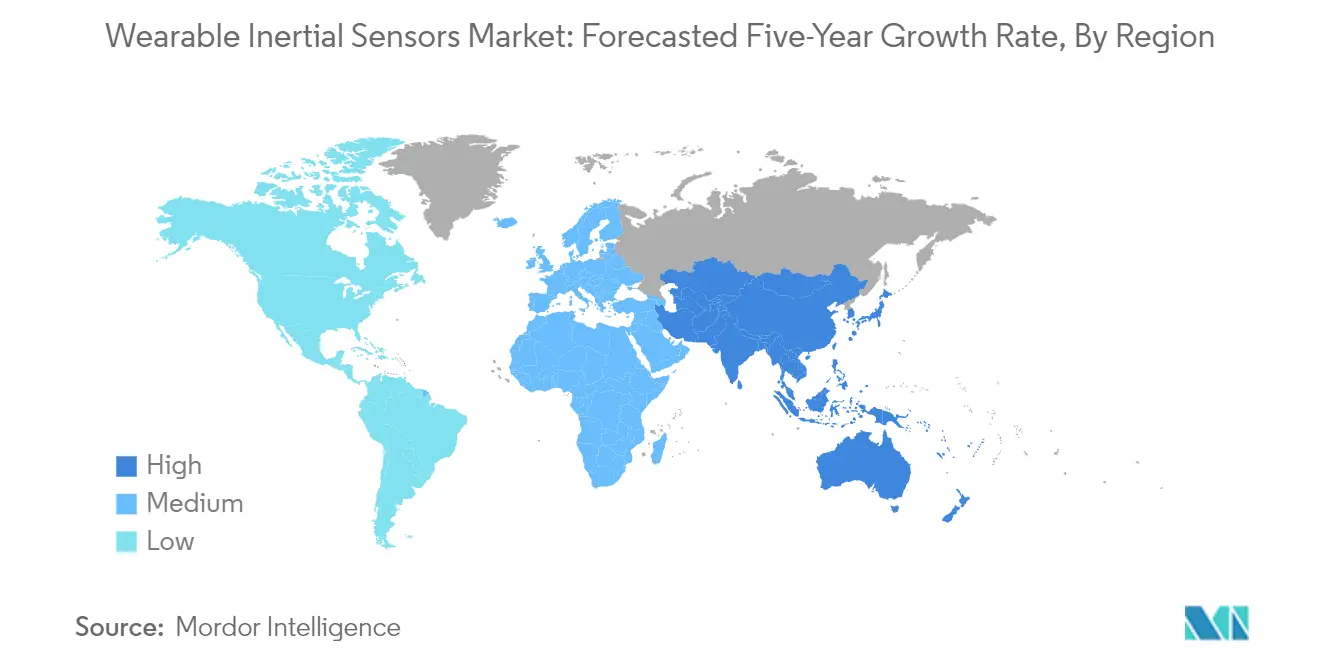
Wearable Inertial Sensors Market in the United States
The United States dominates the North American wearable inertial sensors market, holding approximately 90% of the regional market share in 2024. The country's market leadership is attributed to its robust technological ecosystem, presence of major wearable device manufacturers, and high consumer adoption rates. The healthcare sector particularly drives growth through increasing integration of motion sensors in medical devices and remote patient monitoring systems. The market is further strengthened by continuous research and development activities, strong intellectual property protection, and growing investments in innovative wearable technologies.
Wearable Inertial Sensors Market in Canada
Canada emerges as the fastest-growing market in North America, with a projected growth rate of approximately 10% from 2024-2029. The country's market is characterized by increasing government support for digital health initiatives and growing adoption of wearable inertial sensors across various sectors. Canadian universities and research institutions are actively involved in developing innovative applications for motion sensors, particularly in healthcare and sports performance monitoring. The market benefits from strong collaboration between academic institutions and private sector companies, fostering innovation in wearable sensor technologies.
Wearable Inertial Sensors Market in Europe
Europe represents a significant market for wearable inertial sensors, characterized by strong technological innovation and diverse applications across multiple industries. The region benefits from advanced manufacturing capabilities, strong research and development infrastructure, and supportive regulatory frameworks. Key countries, including Germany, the United Kingdom, and France, demonstrate varying strengths in different application areas, from industrial applications to consumer electronics and healthcare solutions.
Wearable Inertial Sensors Market in Germany
Germany leads the European market with approximately 23% market share in 2024, establishing itself as the region's technological powerhouse. The country's strength lies in its robust industrial base, advanced manufacturing capabilities, and strong focus on Industry 4.0 initiatives. German companies are at the forefront of developing sophisticated wearable inertial sensors for industrial applications, healthcare monitoring, and consumer electronics. The market benefits from substantial research and development investments and strong collaboration between industry and academic institutions.
Wearable Inertial Sensors Market in France
France demonstrates the highest growth potential in Europe, with a projected growth rate of approximately 12% from 2024-2029. The country's market is driven by increasing adoption of wearable technology in healthcare applications and growing investment in digital health initiatives. French companies are particularly active in developing innovative applications for wearable inertial sensors in sports analytics and consumer electronics. The market benefits from strong government support for technological innovation and growing awareness of health monitoring devices among consumers.
Wearable Inertial Sensors Market in Asia Pacific
The Asia Pacific region represents a dynamic market for wearable inertial sensors, characterized by rapid technological adoption and diverse application areas. The region encompasses major manufacturing hubs and emerging economies, with countries like China, India, Japan, and South Korea each contributing uniquely to market growth. The market benefits from large consumer bases, increasing disposable incomes, and growing awareness of health monitoring devices.
Wearable Inertial Sensors Market in China
China leads the Asia Pacific market, establishing itself as the regional powerhouse in wearable inertial sensor technology. The country's dominance is supported by its robust manufacturing infrastructure, large consumer base, and strong government support for technological innovation. Chinese manufacturers are increasingly focusing on developing advanced wearable motion sensors for various applications, from consumer electronics to healthcare monitoring devices. The market benefits from substantial investments in research and development and growing domestic demand for wearable technology.
Wearable Inertial Sensors Market in India
India emerges as the fastest-growing market in the Asia Pacific region, driven by rapid digitalization and increasing adoption of wearable technology. The country's market growth is supported by rising health consciousness among consumers, growing smartphone penetration, and expanding e-commerce channels. Indian companies are actively developing innovative applications for wearable inertial sensors, particularly in healthcare and fitness tracking. The market benefits from government initiatives promoting digital health solutions and increasing investments in technological infrastructure.
Wearable Inertial Sensors Market in Middle East & Africa
The Middle East & Africa region presents a growing market for wearable inertial sensors, with varying levels of adoption across different countries. The region encompasses diverse markets, including the United Arab Emirates, Saudi Arabia, and Israel, each with unique market characteristics and growth drivers. Saudi Arabia leads the regional market in terms of size, while the rest of the Middle East & Africa shows the highest growth potential. The market is primarily driven by increasing healthcare awareness, growing adoption of smart devices, and rising investments in digital infrastructure across the region.
Wearable Inertial Sensors Market in Latin America
Latin America demonstrates significant potential in the wearable inertial sensors market, with countries like Brazil, Argentina, and Mexico showing increasing adoption of wearable technology. Brazil emerges as the largest market in the region, while the rest of Latin America shows the highest growth potential. The market is characterized by growing health consciousness, increasing smartphone penetration, and rising demand for fitness tracking devices. Regional growth is supported by improving digital infrastructure, expanding e-commerce channels, and increasing awareness of health monitoring devices among consumers.
Wearable Inertial Sensors Industry Overview
Top Companies in Wearable Inertial Sensors Market
The wearable inertial sensors market is characterized by intense innovation and strategic developments from leading players, including Texas Instruments, Panasonic, Bosch Sensortec, Knowles Electronics, and Honeywell International. Companies are heavily investing in research and development to create advanced MEMS-based sensors with improved precision, reduced power consumption, and enhanced integration capabilities. The industry demonstrates strong operational agility through flexible manufacturing processes and robust supply chain networks, enabling quick responses to changing market demands. Strategic partnerships with technology firms and research institutions are becoming increasingly common to accelerate product development cycles and expand application possibilities. Market leaders are actively pursuing geographical expansion, particularly in emerging economies across the Asia Pacific, while simultaneously strengthening their presence in established markets through enhanced distribution networks and customer support services.
Market Structure Shows Dynamic Competitive Environment
The wearable inertial sensors market exhibits a balanced mix of global conglomerates and specialized sensor manufacturers, creating a diverse competitive landscape. Large multinational corporations leverage their extensive resources, established brand reputation, and cross-industry expertise to maintain market leadership, while specialized players carve out niches through focused innovation and customized solutions. The market demonstrates moderate consolidation, with key players controlling significant market share through their technological capabilities and comprehensive product portfolios. Mergers and acquisitions are increasingly being utilized as strategic tools to acquire new technologies, expand product offerings, and penetrate emerging application segments.
The competitive dynamics are further shaped by the presence of semiconductor manufacturers who are vertically integrating their operations to include sensor development and production. These players bring substantial manufacturing expertise and established relationships with electronic device manufacturers, influencing market structure and competition patterns. Regional players, particularly in the Asia Pacific, are gaining prominence through cost-effective solutions and strong local market understanding, though global players maintain advantages in high-performance applications requiring advanced technology and quality assurance.
Innovation and Adaptability Drive Future Success
Success in the wearable inertial sensors market increasingly depends on companies' ability to balance technological advancement with cost-effectiveness while maintaining high-quality standards. Incumbent players must focus on continuous innovation in sensor miniaturization, power efficiency, and integration capabilities while strengthening their intellectual property portfolios to maintain competitive advantages. Building strong relationships with end-device manufacturers and understanding evolving application requirements are crucial for maintaining market position. Companies must also invest in developing comprehensive solution ecosystems, including software and analytics capabilities, to differentiate their offerings and create higher entry barriers.
For emerging players and contenders, success lies in identifying and exploiting specific market niches where they can build competitive advantages through specialized expertise or unique value propositions. The relatively low substitution risk in the market provides opportunities for new entrants, though they must navigate challenges related to established player relationships and technology patents. Regulatory compliance, particularly in healthcare and automotive applications, represents both a challenge and opportunity, with companies that can effectively navigate these requirements gaining competitive advantages. The increasing focus on data privacy and security in wearable devices also presents opportunities for differentiation through enhanced security features and certifications. Additionally, the integration of motion sensors and kinematic sensors into wearable devices is becoming a key differentiator, offering enhanced functionality and user experience. Companies focusing on biomechanical sensors are also finding new opportunities in sports and healthcare applications, where precision and reliability are paramount.
Wearable Inertial Sensors Market Leaders
-
Texas Instruments Incorporated
-
Panasonic Corporation
-
Bosch Sensortec GmbH
-
Knowles Electronics
-
Honeywell International Inc.
- *Disclaimer: Major Players sorted in no particular order
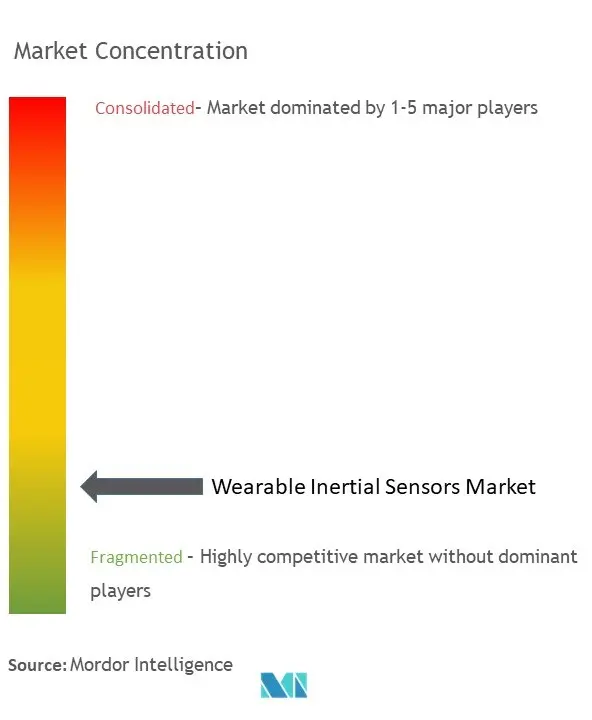
Wearable Inertial Sensors Market News
- January 2023 - Wearable Devices Ltd. established a partnership with a Fortune 500 communications equipment firm (the partner) as an Independent Software Vendor ("ISV"). The partnership will make it easier for the partner's chipset to include the Mudra Neural Input technology. All of the partner's clients that manufacture wearables will be able to use a touchless input platform that is ready to deploy due to Mudra technology which combines its sensors and artificial intelligence (AI).
- December 2022 - Panasonic Industries introduced a new member of its famous Grid-Eye sensor family with a 90° lens that provides a broader field of vision (FoV) and reduces the number of sensors needed to cover a given area, enabling people to count and track applications. Grid-Eye 90° will improve systems built to track and calculate the movement of individuals and other applications. Privacy-conscious designers have praised the Grid-Eye family's 64-pixel resolution.
Wearable Inertial Sensors Market Report - Table of Contents
1. INTRODUCTION
- 1.1 Study Assumptions and Market Definition
- 1.2 Scope of the Study
2. RESEARCH METHODOLOGY
3. EXECUTIVE SUMMARY
4. MARKET INSIGHTS
- 4.1 Market Overview
-
4.2 Industry Attractiveness - Porter Five Force Analysis
- 4.2.1 Bargaining Power of Suppliers
- 4.2.2 Bargaining Power of Consumers
- 4.2.3 Threat of New Entrants
- 4.2.4 Threat of Substitute Products
- 4.2.5 Intensity of Competitive Rivalry
- 4.3 Impact of COVID-19 and Macro Economic Trends on the Industry
- 4.4 Technology Snapshot
5. MARKET DYNAMICS
-
5.1 Market Drivers
- 5.1.1 Increasing health awareness
- 5.1.2 Growing Demand for Wearable Fitness Monitors
- 5.1.3 Rapid Technology Advancements
-
5.2 Market Restraints
- 5.2.1 Security concerns
- 5.2.2 High cost of the devices
6. MARKET SEGMENTATION
-
6.1 By Product Type
- 6.1.1 Smart Watches
- 6.1.2 Fitness Bands/Activity Tracker
- 6.1.3 Smart Clothing
- 6.1.4 Sports Gear
- 6.1.5 Others
-
6.2 By End-user Type
- 6.2.1 Healthcare
- 6.2.2 Sports and Fitness
- 6.2.3 Consumer electronics
- 6.2.4 Entertainment and Media
- 6.2.5 Government and Public Utilities
- 6.2.6 Others
-
6.3 By Geography
- 6.3.1 North America
- 6.3.1.1 United States
- 6.3.1.2 Canada
- 6.3.2 Europe
- 6.3.2.1 Germany
- 6.3.2.2 United Kingdom
- 6.3.2.3 France
- 6.3.3 Asia
- 6.3.3.1 China
- 6.3.3.2 India
- 6.3.3.3 Japan
- 6.3.3.4 South Korea
- 6.3.3.5 Australia and New Zealand
- 6.3.4 Middle East and Africa
- 6.3.4.1 United Arab Emirates
- 6.3.4.2 Saudi Arabia
- 6.3.4.3 Israel
- 6.3.5 Latin America
- 6.3.5.1 Brazil
- 6.3.5.2 Argentina
- 6.3.5.3 Mexico
7. COMPETITIVE LANDSCAPE
-
7.1 Company Profiles
- 7.1.1 Texas Instruments Incorporated
- 7.1.2 Panasonic Corporation
- 7.1.3 Bosch Sensortec GmbH
- 7.1.4 Knowles Electronics
- 7.1.5 Honeywell International Inc.
- 7.1.6 TE Connectivity Ltd
- 7.1.7 Analog Devices Inc
- 7.1.8 General Electric Co.
- 7.1.9 AMS osram AG
- 7.1.10 STMicroelectronics NV
- 7.1.11 Infineon Technologies AG
- 7.1.12 NXP Semiconductors NV
- 7.1.13 InvenSense, Inc. (TDK Corporation)
- *List Not Exhaustive
8. INVESTMENT ANALYSIS
9. MARKET OPPORTUNITIES AND FUTURE TRENDS
Wearable Inertial Sensors Industry Segmentation
Wearable inertial sensors are portable sensors used independently to measure various intended functions or to form an integrated 3D sensing unit. Wearable inertial sensors track a user's motion, orientation, and movement within a device. An accelerometer, which monitors the acceleration imparted to it from any direction, is a typical example. They can be utilized for various tasks, including tracking user movements or gestures, calculating body performance metrics, and tracking daily physical activity levels. Wearable inertial sensors come in various varieties, each with special benefits.
The wearable inertial sensors market is segmented by product type (smartwatches, fitness bands/activity trackers, smart clothing, sports gear, and other products), end-user industry (healthcare, sports & fitness, consumer electronics, entertainment & media, government & public utilities, and other end users), and geography (North America (the United States, and Canada), Europe (Germany, United Kingdom, France, and rest of Europe), Asia Pacific (China, India, Japan, South Korea, and rest of Asia Pacific), Middle East & Africa (United Arab Emirates, Saudi Arabia, Israel, and the rest of the Middle East & Africa), Latin America (Brazil, Argentina, Mexico, and rest of Latin America )). The market sizes and forecasts are provided in terms of value USD for all the above segments.
| By Product Type | Smart Watches | ||
| Fitness Bands/Activity Tracker | |||
| Smart Clothing | |||
| Sports Gear | |||
| Others | |||
| By End-user Type | Healthcare | ||
| Sports and Fitness | |||
| Consumer electronics | |||
| Entertainment and Media | |||
| Government and Public Utilities | |||
| Others | |||
| By Geography | North America | United States | |
| Canada | |||
| Europe | Germany | ||
| United Kingdom | |||
| France | |||
| Asia | China | ||
| India | |||
| Japan | |||
| South Korea | |||
| Australia and New Zealand | |||
| Middle East and Africa | United Arab Emirates | ||
| Saudi Arabia | |||
| Israel | |||
| Latin America | Brazil | ||
| Argentina | |||
| Mexico | |||
Wearable Inertial Sensors Market Research FAQs
How big is the Wearable Inertial Sensors Market?
The Wearable Inertial Sensors Market size is expected to reach USD 0.85 billion in 2025 and grow at a CAGR of 10.95% to reach USD 1.44 billion by 2030.
What is the current Wearable Inertial Sensors Market size?
In 2025, the Wearable Inertial Sensors Market size is expected to reach USD 0.85 billion.
Who are the key players in Wearable Inertial Sensors Market?
Texas Instruments Incorporated, Panasonic Corporation, Bosch Sensortec GmbH, Knowles Electronics and Honeywell International Inc. are the major companies operating in the Wearable Inertial Sensors Market.
Which is the fastest growing region in Wearable Inertial Sensors Market?
Asia is estimated to grow at the highest CAGR over the forecast period (2025-2030).
Which region has the biggest share in Wearable Inertial Sensors Market?
In 2025, the Asia accounts for the largest market share in Wearable Inertial Sensors Market.
What years does this Wearable Inertial Sensors Market cover, and what was the market size in 2024?
In 2024, the Wearable Inertial Sensors Market size was estimated at USD 0.76 billion. The report covers the Wearable Inertial Sensors Market historical market size for years: 2019, 2020, 2021, 2022, 2023 and 2024. The report also forecasts the Wearable Inertial Sensors Market size for years: 2025, 2026, 2027, 2028, 2029 and 2030.
Our Best Selling Reports
Wearable Inertial Sensors Market Research
Mordor Intelligence provides a comprehensive analysis of the wearable inertial sensors industry. We leverage decades of expertise in tracking technological advancements in motion sensors and movement sensors. Our extensive research covers the complete ecosystem of wearable inertial measurement units. This includes detailed analysis of motion tracking sensors and biomechanical sensors. The report examines various applications, ranging from human motion tracking to advanced body motion sensors. It offers stakeholders crucial insights into market dynamics and technological innovations.
Our detailed market analysis is available as an easy-to-download report PDF. It provides in-depth coverage of key components, including wearable accelerometer, wearable gyroscope, and wearable magnetometer technologies. The comprehensive study examines kinematic sensors applications across various industries. It offers valuable insights for manufacturers, investors, and industry participants. The report delivers actionable intelligence on wearable motion sensors development, emerging technologies, and growth opportunities. This enables stakeholders to make informed strategic decisions in this rapidly evolving market segment.

